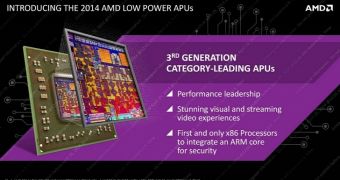Just last week, Advanced Micro Devices revealed its Beema and Mullins accelerated processing units, and there was one very important thing there that drew my attention and made me think of what unique things might come in the future.
I am, of course, speaking of the integrated ARM processor, the chip (or integrated circuit) that gives the new APUs (accelerated processing unit) their uncanny security feature.
Just in case you weren’t around when the information came out, there is an ARM core inside the APUs, only that it’s not really meant to process data, exactly.
Instead, it divides the processor into two halves. One half, the heavily encrypted one, takes care of outgoing and incoming network/internet connection, as well as removable media and the like.
The other half handles everything else, the data that is stored natively, that’s already “yours” as it were. AMD calls all this the TrustZone technology.
What this means
Essentially, Advanced Micro Devices is really moving forward with the whole “hybrid chip” thing, the Fusion concept. Only that this time, it’s not about merging the CPU with the GPU anymore.
After all, that’s already been accomplished. So now, the Sunnyvale company is moving towards hybrid ARM-x86 processors.
And since it can’t exactly leap straight into multi-core, hybrid chips, it’s putting the low-power ARM architecture to good use wherever it can. In this case, AMD used it to create its own way of safeguarding data.
Intel has real-time encryption at processor level, AMD has task distribution of such nature that only half of the resources need to be bogged down with security protocols, many of which happen unnoticed in the background anyway.
Having ARM tech managing the security of an x86 processor is just the beginning though.
Something good could happen in the next few years
Long story short, the ARM integration into the AMD Beema and Mullins APUs made me think that there was only one step left before ARM and x86 processing was combined.
It doesn’t really have to be “all the way” either. x86 Technology is much, much better in terms of sheer horsepower after all.
Nothing says that AMD can’t stuff an odd core there to handle low-end tasks though. We’ve already seen it happen in fact, though it was done by NVIDIA in the Tegra 4-PLUS-1 SoCs (system-on-chip devices).
To elaborate, the Tegra 4 is, technically, a quad-core ARM SoC, but there is a fifth core too, a lower-power one, which takes over when nothing too strenuous is being run. While it’s active, everything else (except the GPU) is powered down.
This saves a lot of power, and it’s the primary reason why some Android-loaded tablets can last for 8-12 hours on a single charge, sometimes even more.
AMD could have CPUs and APUs with four-8 x86 cores, and an extra ARM core to perform the same function as in the Tegra. And given the time it took to go from CPU to APU and, now, APU with ARM security, I’m thinking that AMD could pull this off by, say, 2017-2018. No later than 2019-2020 though, if it happens at all.
The company might have to go through some intellectual property spats before it can employ something like 4-PLUS-1 if NVIDIA patented the essential concepts, but it’s doable. More importantly, it would fit AMD’s new MO, to use both x86 and ARM technology.

 14 DAY TRIAL //
14 DAY TRIAL //